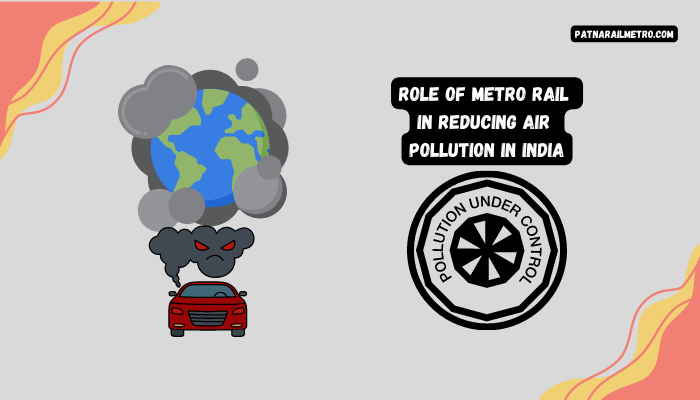Air pollution has become a major issue in India due to rapid urbanization and the myriad of vehicles on the road causing traffic. The problem is posing a significant threat to the environment and public health. Air pollution has become a major issue affecting the quality of life for millions of people.
The role of metro rail systems in reducing air pollution in India has gained importance as an effective measure to combat the problem. The metro rail networks provide an eco-friendly and cost-effective mode of transportation. The use of private vehicles, a major contributor to pollution, can be minimized by utilizing the metro rail networks.
The Metro rail system can help reduce urban transport’s carbon footprint by focusing on electric power, efficient operations, and reduced emissions. It is achieved by generating electricity through renewable sources such as solar and wind energy.
Metro rail systems play a vital role in reducing air pollution by lowering the number of private vehicles on the road, a crucial aspect of reducing air pollution. Private vehicles emit harmful pollutants, such as nitrogen oxides, carbon monoxide, and other matter, contributing to air pollution.

Using metro rail systems as a sustainable alternative to private vehicles reduces the dependency on cars and two-wheelers, significantly reducing pollution levels. Additionally, the affordability and dependability of metro rail systems encourage commuters to switch to public transportation, further reducing air pollution levels.
How Is Metro Rail Helping In Reducing Air Pollution?
The efficient functioning of metro rail systems is essential to lowering air pollution levels. Metro rail systems follow a pre-determined route and schedule, allowing commuters to plan their travel accordingly. This helps lower the number of road vehicles, reducing traffic congestion and decreasing air pollution.
In addition, regenerative braking systems in metro rail systems are installed, which convert the train’s kinetic energy into electrical energy. This energy power other components in the train or could be sent back to the power grid. This capability reduces the system’s operating costs and also lowers the metro rail system’s energy consumption.
The role of metro rail systems in reducing air pollution levels in India is critical, considering the current status of pollution levels in the country. A lot of Indian cities rank among the world’s list of most polluted cities, and this has had adverse effects on public health. The pollution has led to respiratory illnesses, heart diseases, and premature deaths. This led to the critical need for sustainable and eco-friendly modes of transportation to reduce pollution levels.
Metro rail systems offer a solution by eco-friendly and cheaper means of transportation. As a result, promoting the use of metro rail systems can significantly lower pollution levels and improve public health in India.
Studies Conducted:
The impact of metro rail systems on air pollution levels has been studied in various cities across India. These studies have been conducted to examine air pollution levels. For example, in Delhi, the introduction of the metro rail system has been found to reduce carbon dioxide emissions by 6.3 lakh tonnes per year, while in Bangalore, the metro rail system has been shown to reduce carbon dioxide emissions by 1.28 lakh tonnes per year.
In Kolkata, a study by the Central Pollution Control Board found that the metro rail system could reduce carbon dioxide emissions by 31,500 tonnes per year. A similar study in Chennai estimated the metro rail system could reduce carbon dioxide emissions by 76,000 tonnes per year. These studies suggest that metro rail systems have the potential to significantly reduce air pollution levels in cities and promote sustainable and eco-friendly modes of transportation.
In addition to lowering air pollution levels, metro rail systems offer various advantages. They provide commuters with a reliable and convenient means of transportation, time, and money. Furthermore, metro rail systems can reduce traffic congestion, enhance road safety, shorten travel time, and enhance residents’ overall quality of life.
Frequently Asked Questions:
A: Metro rail helps reduce air pollution in India by promoting public transportation and reducing the number of private vehicles on the roads. This, in turn, reduces the amount of vehicular emissions that contribute to air pollution.
A: Metro rail is an effective mode of public transportation that can significantly reduce air pollution in India. Studies have shown that cities with metro rail systems have lower air pollution levels than cities without such systems. However, the effectiveness of metro rail in reducing air pollution depends on various factors such as the extent of the network, frequency of trains, and accessibility to stations.
Conclusion:
In conclusion, metro rail systems are critical in reducing air pollution levels in India. They offer a sustainable and cost-effective mode of transportation that can decrease the reliance on private vehicles, consequently reducing pollution levels. Metro rail systems also have the potential to reduce traffic congestion and improve the overall quality of life for residents.
Using renewable energy sources to power metro rail systems contributes to a more sustainable future. Prioritizing the expansion of metro rail systems across Indian cities is essential for addressing the challenges of pollution and sustainable urban development, leading to a cleaner, healthier, and more sustainable future for Indian citizens.
